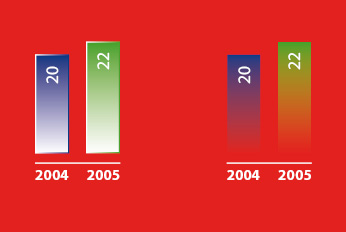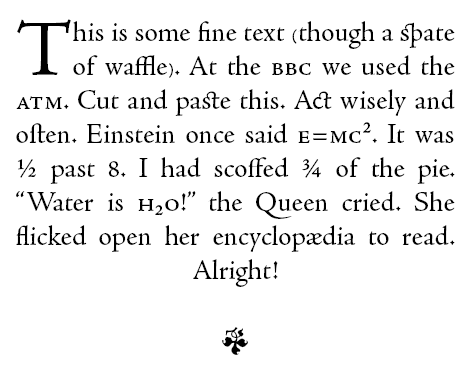InDesign Rocks
16th August 2005 · Last updated: 5th October 2016
I started on a project using Adobe InDesign CS2 today. Here's a sample of two styles of bar chart I came up with. I'm especially pleased with the left chart as the gradient around the edge was not intended! It was one of those moments when you do something cool in a program but you can't say how it happened at the time. A genuine mistake, but worthy of keeping. Some of the best things you do can happen that way. (Ask Radiohead — their classic broken guitar riff in Creep was apparently an accident.)

Next I'd like to show you something I made when learning how to use the program. With much delight I discovered the glyphs window, which basically gives you all those unusual characters that include joined letters and other shapes. Look at the image below and see how many glyphs you can spot. Then click on the image to see them highlighted.
InDesign has undoubtedly restored my interest in typography — I just bought a book full of superb logos and how to make them. The last time I studied typography, letters were set in metal by hand! Apple had just brought out their first Mac I think, but its monotone pixelful screen did not interest me at the time. Drawing by hand was still the way to go. But before I get carried away, back to InDesign. What surprised me is how much power it has in comparison to HTML, or Word. It's designed for creating artwork for printing (via high-quality PDFs) with many more features than anything we can presently do with CSS. (It's actually quite depressing. The web is still so primitive!) Features such as these:
- Limitless fonts (or typefaces as they really should be called)
- Forget italic and bold as the only real choices for web fonts. InDesign can slant lettering at a vast range of angles as you see fit. It also comes with fonts which offer not just normal and bold, but a list of weights, such as semi-bold and black. Ah, my memories of Letraset typeface books are returning!
- In Word and HTML you can justify text left, right, centred or fully. InDesign has four more settings for dealing with things like columns and orphans.
- Kerning is just one example of how you can improve text in a design. It lets you finely adjust the spaces between each letter. CSS does have
letter-spacingbut it's pretty crude by comparison. - Drop-caps, as you can see in the glyphs example, are very easy to create.
There's a lot more, but I can't remember it all right now. I don't know how InDesign compares to Quark and other publishing packages, but it seems pretty extensive. Best of all, it has a typical Adobe interface, meaning if you've ever used Photoshop or another Adobe program, you'll find a lot of it works in the same way. I do have some niggles though:
- It takes ages to load! (No flames please, it's just a fact. About twice as long as any other program I use. The splash screen is there for several seconds, and even when it disappears, you're left looking at empty toolbars for a few seconds before the program becomes usable.)
- I know it's down to the way Adobe programs allow parts of them to be removed and added for easy maintenance, but I don't like the way selecting something in a list of properties makes you wait seconds for the window to be populated. It looks like drop-down menus and text are being loaded into the program on demand, or being heavily uncompressed. I wouldn't be surprised if they're all in XML.
- Likewise, the Help menu does nothing for a couple of seconds before it appears. There are obviously parts of it that have to be loaded into place first, but this looks bad on today's mega-fast computers.
- Columns could do with an easy way to add a central line between them. (If there's a way, let me know.)
I could go on, but it would be nitpicking. All the above niggles are worth enduring as InDesign's clearly a very useful program, with tons of options. You have to admire Adobe for it. I just hope I don't find any showstopper bugs (there's always one hiding somewhere in every program!). Well I hope you enjoy the samples I showed you above. InDesign rocks.
